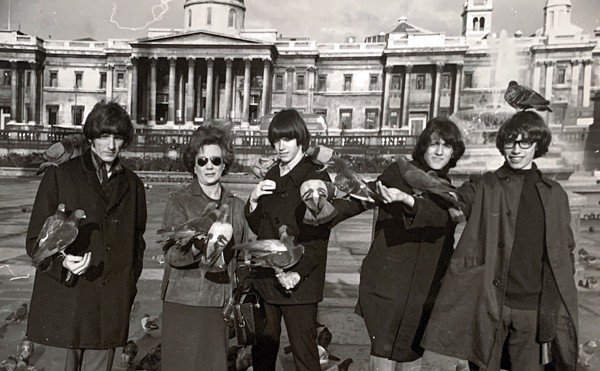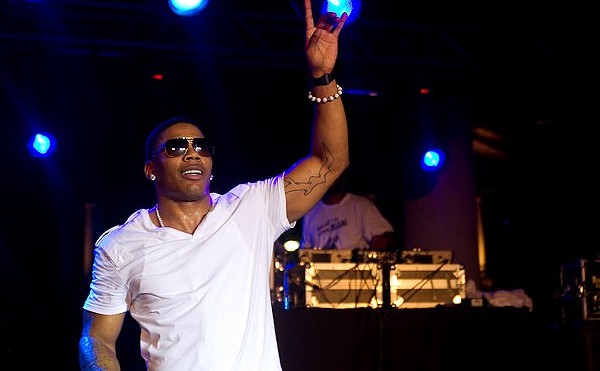B-Sides: What do you make of the Robert Plant comparisons, and what do you think of his work with the Honeydrippers?
Erika Wennerstrom: I think Robert Plant's great, so I definitely take it as a compliment. And I listen mainly to Led Zeppelin, so I can't say much either way about his other work.
How did you end up with the Southern label Fat Possum? Describe that courtship process.
We played in Akron. There were five people there. Patrick Carney from [Possum labelmate] the Black Keys walked in halfway through our set. We ended up hanging out, and I had a CD I gave to him. We were on a little tour, and when we got back, I guess Fat Possum had been e-mailing and it'd been going to my junk mail folder. I never used to check my junk mail folder, but fortunately Mike [Lamping, the Bastards' bassist] decided to check it.
Do you consider your native southern Ohio to be more Midwestern or Southern culturally, and how has this culture influenced you artistically?
I guess it's sort of right on the edge of the South. A lot of times people say I have a Southern accent. The drunker I am, the more Southern I sound, for some reason.
Do you consider bands from the middle of the nation to be somehow more resilient or authentic than bands from the coasts?
I do find that a lot of the music that comes out of areas other than the east and west is a lot less poppy. And what I have noticed is clubs here will book all these bands from New York that nobody's ever heard of just because it sounds cool that they're from New York.
What sort of vehicle do y'all tour the country in, and what is its most recurrent mechanical failure?
I bartended for years and just picked up as many shifts as I could and saved up as much money as I could and wrote songs as I did it. So I put a down payment on a '99 Dodge Ram van like three years ago and have taken really good care of it. It's been really good to us, but it's starting to rack up some miles. I've always envisioned us breaking down in a giant sandstorm in the desert with a busted air conditioner. — Mike Seely
9 p.m. Saturday, April 1. Blueberry Hill's Duck Room, 6504 Delmar Boulevard, University City. $10. 314-727-4444.
Think for a Minute
Hayseed Dixie, the self-appointed ambassadors of rock-grass, effortlessly weave banjos and fiddles into AC/DC and Led Zeppelin standards while squeezing out originals like "I'm Keeping Your Poop." Lead vocalist John Wheeler told B-Sides that his experience at Marquette University wasn't to get a specific occupation, but to overcome his fear of being stupid (he graduated after majoring in philosophy, history and English). So we juxtaposed excerpts from our interview with Wheeler (a.k.a. Barley Scotch) with philosophical concepts summed up from The Dictionary of Theories.
Contextualism: In aesthetics, art can only be appreciated by reference to their context, circumstances of production and artists' intuitions.
John Wheeler: Whether or not something is art, somebody two or three hundred years from now is going to decide that, and I'll already be dead and it won't make any difference. I don't know that Mozart was trying to create a great piece of art when he wrote "The Magic Flute," for example. I think he was probably trying to make his kids smile and maybe get paid. Probably in the reverse order of that.
Psychologism: The habit of treating philosophical or theoretical problems as though they were psychological ones, to be solved by methods such as introspection.
Wheeler: People have never really sat down and thought through what is the center and focus of their life and where they fit into their historical and cultural context. But it makes the common person have to work a little harder to get comfortable in their own skin, philosophically. You have to figure it out for yourself [and] that involves learning about history and philosophy and literature and stuff. Just to make your soul enriched. You can't really fill that by going and buying a bunch of TV sets and PlayStations and shit.
Abstractionism: View that the mind gets some or all of its concepts by abstracting them from concepts it already has or from experience.
Wheeler: Maybe that guy in Coldplay would be fun to drink beer with, but I don't get that feeling from listening to his records. Like that song, "It was all yellow....." What was all yellow? Nowhere in the song does he tell us what was all yellow. I ain't got a clue! The best I can I figure is when you eat a lot of vitamins and asparagus, your pee comes out all yellow. But if you're drinking beer like I am, your pee comes out clear. Obviously the boy ain't drinking enough.
— Kristie McClanahan
9 p.m. Thursday, March 30. Blueberry Hill's Duck Room, 6504 Delmar Boulevard, University City. $12. 314-727-4444.
Clothes Encounters
The male punk-rocker, while outwardly flamboyant and intimidating, is a creature wrapped in mystery. To the outside world, his dress may appear to indicate antisocial behavior or desperate cries for attention. But as those who move within his realm know, there are more subtle innuendos brewing just beneath his flashy surface. Using New York punk fashionistas the Casualties as code, B-Sides was able to decipher some of the trickier meanings behind the male punk's attire.
The Hair
The height of the young male punk's hairdo, be it liberty spikes or Mohawk, is much like the middle-aged man's Corvette. The hair's height is said to bolster the ego, making up for something else lacking in their lives (like employment, perhaps). The color of the male's hair is meant to signal the female of the species. The brighter the hair, the more virile the male. For instance, lead singer Jorge's signature bright-red spikes indicate a healthy libido shelved inside a vulnerable man, as the crooning in "Punk Rock Love" proves.
The Outfit
For a male punk to take the stage sporting his own band's T-shirt is a sin of vanity. However, it is OK to coerce other bands into wearing one's own shirts, as the Casualties do in their new DVD, Can't Stop Us, when they run into the lead singer from the UK Subs. (It is a sign of dedication, though, if a male punk has a tattoo of his band's logo, as guitarist Jake does.)
Tight pants work double-duty for the male punk. Not only do they wick away perspiration during sweaty performances, but the pants also accentuate the male punks' typically emaciated bodies — thereby eliciting a more nurturing response from the often-hostile female punks.
Studded vests and jackets serve as both armor and bragging rights. Each stud actually represents every drunken brawl a punk got into before he turned eighteen. Any male punk under this age wearing a meticulously studded jacket has actually foregone the DIY punk work ethic and had either his mother or girlfriend do it for him.
Accessories
In the early days of Sid and Nancy, the padlock necklace that both Jake and drummer Meggers wear meant a male punk was taken. Nowadays there is no such thing as a touring male punk who is not available for a fling.
The meaning behind the multiple belts a male punk dons has been hotly contested, but most often they correlate with the number of successful bands a member has toured with. For the many bands that can be classified as unsuccessful (i.e., ones that still haven't done a stint on the Warped Tour), a belt is earned for each year committed to the band. Bullet belts signify seniority within the band — like Jorge's, since he is the only original member left in the Casualties.
— Andrea Noble
7:30 p.m. Wednesday, April 5. Pop's, 1403 Mississippi Avenue, Sauget, Illinois. $13.50 to $15. 618-274-6720.





